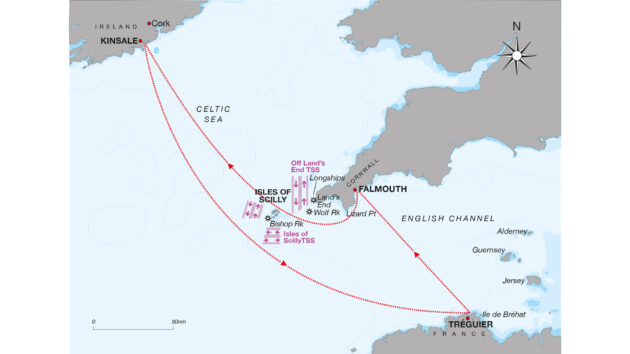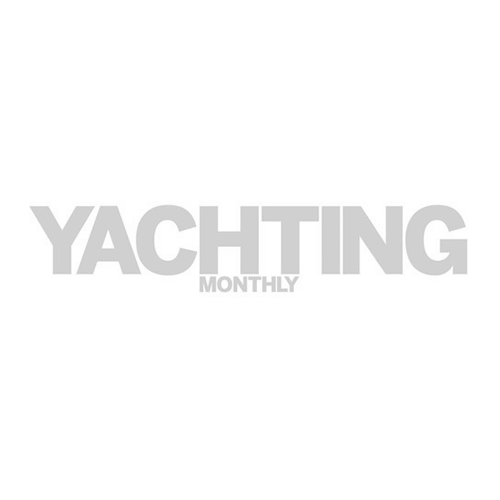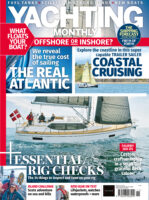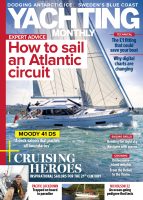Ever wanted to try your hand at offshore racing? We take a look at the Yachting Monthly Triangle Celtic Triangle Race and the crews taking part in this entry-level offshore event
Have you ever wondered what it would be like to push yourself and your boat a bit harder than you normally would? What does it feel like to sail offshore, shorthanded or even solo, and what would it be like to race rather than cruise at leisure? Well, if you want an answer to any of those questions, then the Yachting Monthly Celtic Triangle Race has been created for you.
Growing out of the boom in shorthanded offshore sailing in the 70s and 80s, with the likes of the Golden Globe Race and the OSTAR, as well as the Azores and Back Race, run by the Royal Cornwall Yacht Club since the 1970s, the Yachting Monthly Triangle Race was first run 1984 and continued with great success for many years with the Royal Torbay Yacht Club, but Covid killed off the event.
Thanks to the enthusiasm of the UK Doublehanded Offshore Series (UKDHOS) and the Solo Offshore Racing Club (SORC), however, the event has been reborn under the auspices of the Royal Cornwall Yacht Club as the Yachting Monthly Celtic Triangle Race.
While this brings some fairly battle-hardened and serious racing boats and skippers to what was previously a purely Corinthian event, it has created a vibrantly varied fleet in which there is still ample space for the amateur and novice offshore skipper.

Competitors make their way past the Black Rock beacon in Falmouth. Photo: R Hastings / Getty Images
What boats take part in the Yachting Monthly Celtic Triangle Race?
At the time of going to press, roughly half the fleet is made up of cruising boats, including Rustlers, Dufours, Sigmas and Westerlys, to name a few, and a very healthy entry list of nearly 40 boats.
Race organiser Jonathan Money explained, ‘Without the support of the two shorthanded racing associations, this event simply wouldn’t have got off the ground. We are delighted that they were keen to include the event in their series, and this has created a space in which novices can have a go as well.’
The boats will compete over a course of roughly 600 miles, broken up into two shorter legs and one longer leg in a triangle from Falmouth to Kinsale in southern Ireland.
After a stopover of three days, the fleet departs for Tréguier in Brittany, and then back to Falmouth, completing the whole circuit within a two-week window. The legs are long enough to provide a proper taste of offshore sailing, without being so long or so remote as to be overwhelming to a skipper who has only done Channel crossings before.

The Royal Cornwall Yacht Club in Falmouth is organising and hosting the race. Photo: RCYC
While many races are relatively impersonal affairs in which crews sail from their home ports, start, finish and sail home again, the Celtic Triangle race is hugely sociable. Crews gather a few days before the start in Falmouth where they meet other crew, receive race briefings and attend a dinner hosted by the RCYC before setting off.
A couple of days later and they will be enjoying Irish hospitality (one of the possible hazards of the race, according to veterans), and again in France, where the fleet is paraded through the town by Breton pipers, and the Mayor personally hosts the drinks do before a jolly good prize-giving lunch back in Falmouth.

Kinsale makes a welcoming first stop. Photo: David Lyons/Alamy
This is a fleet in which competitors help each other both in harbour and on the water, and the sense of camaraderie of a rally builds as characters emerge and the fleet jointly face the challenge of the sea. That’s not to say that any punches will be pulled once the start gun goes, and there was plenty of chat among the skippers before the event about how many spinnakers they would be allowed to carry and how strictly IRC ratings rules be enforced.
For skippers that haven’t been offshore or raced before, however, just completing the course will be enough of a challenge.
Sailing the Celtic Triangle
Jayne Toyne has competed in the Triangle Race four times, as well as the Azores and Back Race once (but was dismasted). She will be sailing the Celtic Triangle again this year, this time with skipper Mary Sturgess aboard Mary’s J105 Jaldi, a five-time Triangle veteran. Jayne answered a few questions about preparing for and taking part in the event:

If you’ve crossed the Channel and sailed offshore at night, you’re probably up to the challenge. Photo: Marina Foti
How do you know you are up to the challenge?
‘It’s hard to define exactly when someone is ready to take part in an event of this kind. It’s down to the individual to know or trust in their abilities to get around the course safely and quickly.
‘The fact it’s called an offshore race makes it sound grander than it is. The race never asks more than two nights at sea at the very most. The longest leg is only around 290 miles. But, as a rough idea, I’d say if you’ve crossed the English Channel a few times and spent nights at sea then you’ll be ready to take it on.
‘Choose your co-skipper wisely. Are they someone you trust implicitly? Can you really go off watch and trust them to make safe and fast decisions while you rest? The key to a successful race lies very much in the partnership you have with your co-skipper. The race isn’t quite a marathon, but it’s not quite a sprint either.’

Ensure you have a co-skipper you get on with and trust implicitly. Photo: Jane Toyne
How do you prepare for the Yachting Monthly Celtic Triangle Race?
‘Qualification entails either a qualifying race, or a non-stop 125-mile passage, out of sight of land for the majority, in the boat and with the crew you will be competing with. Not exactly difficult, but equally it’s a proving ground for you and your co-skipper to make sure you have a night routine organised between you, as well as an eating plan.
‘One year I made the silly mistake of not planning food adequately for leg one and when my co-skipper was laid low with mal-de-mer for the entire first leg, I lived on jam doughnuts for about 18 hours before I was able to get proper food sorted.’
Is my boat up to it?
‘The race is a Category 3 event with a few requirements of Category 2 such as the liferaft, but the entry requirements are not too arduous. Your boat will need to comply to World Sailing regs for that category. They also must comply to the notice of race conditions, which can differ a little, and you will need to have your boat measured to get an IRC certificate and rating.
‘I keep a book with the World Sailing regs printed out and stuck within the pages and use this as a check list to regularly consult to ensure I am complying with the latest rules and regulations.
‘The key isn’t about getting away with as little as possible, but looking at what is the category up from the event you plan on doing and seeing how much can be completed above and beyond the basic requirements.
‘Your boat and your crew will thank you for your diligence at this point. The preparations for an event such as the Triangle race will pay off for the rest of the year as you’ll be sailing with a boat that is truly “sorted” and in very best fettle.’

Crews need to have completed either a qualifying event, or 125 miles offshore together. Photo: Jane Toyne
What training and qualifications do I need to have completed?
‘You don’t actually need a Yachtmaster qualification but you do need to be able to demonstrate to race control that you have sufficient sea miles under your belt and experience from logbook entries.
‘You do need one first aider onboard. Ideally both of you will have a first aid certificate from RYA. For Cat 3 races, only one of you needs to have completed sea survival training, though I would recommend that everyone has this certificate of competency. The two-day course is required. One of you also needs a VHF radio licence.
‘In addition to these, I recommend that both of you are familiar with your lifejackets in their inflated mode in the water (ask your local swimming pool), including the placement and method of activation of personal AIS beacons and PLBs if you have them.
‘Practise learning where everything is on your lifejacket without looking. Wear it manually inflated (via the oral tube) so you know what it feels like. When you do this, it’s the ideal time to remind yourself where your beacons are. If possible go through dummy drills of “activating” your beacons.

Sea survival training is a requirement. Photo: Andrew Sydenham
‘Check that the sprayhood doesn’t collapse a beacon antenna for example. Just don’t go triggering your PLB by accident and then having to do the call of shame to the Coastguard to stand down the rescue helicopter they just scrambled to 21 Acacia Avenue!’
What does the event mean to you?
‘I’ll be bold and say that this race changed my life. I have met lifelong friends through this event thanks to the friendly, sociable and welcoming stopovers, and by repeated entry over the years I have learned a lot about myself, my boat and used it to improve my sailing skills.
‘By being forced to sail both when there is no wind and in very windy conditions, you quickly find your weaknesses and you have no other way around it but to face them and get on with it, which usually means coming out of the event a stronger, more competent sailor as a consequence.’

The Yachting Monthly Celtic Triangle Race course
The three-legged Celtic Triangle course takes a fleet of up to 40 single- and doublehanded yachts to three Celtic coastlines over a distance of 600 miles. The challenge of the course is that much of it is in coastal waters with all of the shipping, tidal gates and headlands that entails, but it is also long enough that it is no round-the-cans sprint.
From Falmouth to Kinsale is a distance of approximately 190 miles, followed by a long-haul from Kinsale to Tréguier of 300 miles, and finally Tréguier to Falmouth, over 110 miles. Stop-overs in Kinsale and Tréguier are an attractive feature of the race and are long enough to allow crews to recover, prepare and socialise before the next leg.

There will be some serious race boats on the course, as well as more Corinthian entries this year. Photo: Hugh Hastings
Yachting Monthly Celtic Triangle Race rules
The race is open to seaworthy monohull yachts with hull length (IRC ‘LH’) between 7.62m and 14.61m. They must be sailed throughout either singlehanded or doublehanded, with the same crew. All yachts need a current and valid IRC rating and have completed a Boat/Crew Declaration by 8 May.
Qualifying races or passages are: the Triangle Race 2018; one or more RORC, JOG or SORC offshore races amounting to 200 miles in total and including two overnight segments, completed since 8 June 2023.
Alternatively a non-stop qualifying passage of 125 miles, under sail alone, mostly out of sight of land and by the boat and crew entered in the race.
The regatta will be governed by the rules as defined in the Racing Rules of Sailing (RRS). World Sailing Offshore Special Regulations (OSR) 2024-2025 will apply. The event is classified as OSR Category 3 plus Category 2 liferaft, hull construction standards and inboard engine requirements. Boats are also required to transmit on AIS using their boat names rather than MMSI numbers alone.
Boats also need to carry floating waterproof torches for night-time man overboard scenarios, and crews need to wear lifejackets and harnesses at night, when alone on deck, when reefed, in more than 25 knots of wind or in visibility of less than a mile. Boat details need to be registered with the Coastguard via the RYA SafeTrx app, although the journey function of the app will not be used. (To see the full rules, visit www.yachtingmonthly.com/celtictriangle25)

The prize-giving takes place in Falmouth. Photo: RCYC
How to watch the Triangle Race
To watch the start, get a front row view of the Pendennis start line from Pendennis Castle on Sunday 8 June at 1600.
There is no live tracking, but to get all the latest updates, visit www.yachtingmonthly.com/celtictriangle25.
You can follow individual boats on AIS via www.marinetraffic.com, where you can search for boat names.
Competitors will be posting to Facebook and Instagram. Follow #RCYC and #ymceltictriangle to get the latest news and updates.
Results will be announced at the end of each leg via www.royalcornwallyachtclub.org and on the magazine’s website: www.yachtingmonthly.com
Join the next event
Historically, the YM Triangle Race was run every two years, when the AZAB was not being run. The date of the next event is yet to be confirmed, and timing will be dictated by the level of interest from participants. If you, your club or association are interested in joining or supporting the event, contact sailing@royalcornwallyachtclub.org.

Andrew Bray sailing in offshore events in his Pionier 10 Gillygalloo. Photo: Andrew Bray
Yachting Monthly Triangle Race history
Andrew Bray, former YM editor and co-founder of the YM Triangle ‘The excitement of offshore racing goes back a long way with me. Having been given a copy of Francis Chichester’s book The Lonely Sea and the Sky when I was a teenager, I was inspired to think that one day I’d like to take part in the Singlehanded Transatlantic Race, or OSTAR as it became known.
‘When I joined YM in the early 1970s, Des Sleightholme was editor and his definitions of hands-on seamanship were a million miles from the Blue Book Admiralty Manuals. In turn, my own interpretation of this was that singlehanded sailing was the ultimate test of seamanship and from this I was keen to promote singlehanded sailing through the pages of the magazine. OSTAR was still a dream, although I was fitting out a 32-footer for cruising.
‘A number of readers were suggesting that they’d like to take part in a shorter race than OSTAR, and from this the Azores and Back Singlehanded Race took shape. The first race took place in 1975, which was sponsored by YM and in which I entered in my 32-footer. It was a great success with around 60 entrants.
‘In 1984, by which time I was editor, YM readers were asking for a challenging two-handed race that was long enough to be challenging but short enough to complete within two weeks. The YM Triangle Race was born, organised by the Royal Torbay Yacht Club, with a course from Torquay to Tréguier, then on to Crosshaven in Ireland before heading back to Torquay. [A parallel event was run by the Royal Cornwall YC with stops in Crosshaven and Morgat].
From 1986 onwards, the event was run by the RTYC until 2018, with the 2020 event cancelled due to Covid. When the event struggled to attract enough entries, Royal Cornwall YC stepped in and picked up the event once more. It is great to see it being rejuvenated, and so the story continues.
‘I did manage to enter OSTAR in 1976 but like a good number of competitors that year failed to finish because of breakages and extreme weather.’
Enjoyed reading this?
A subscription to Yachting Monthly magazine costs around 40% less than the cover price, so you can save money compared to buying single issues.
Print and digital editions are available through Magazines Direct – where you can also find the latest deals.
YM is packed with information to help you get the most from your time on the water.
-
-
- Take your seamanship to the next level with tips, advice and skills from our experts
- Impartial in-depth reviews of the latest yachts and equipment
- Cruising guides to help you reach those dream destinations
-
Follow us on Facebook, Twitter and Instagram.
Note: We may earn a commission when you buy through links on our site, at no extra cost to you. This doesn’t affect our editorial independence.





